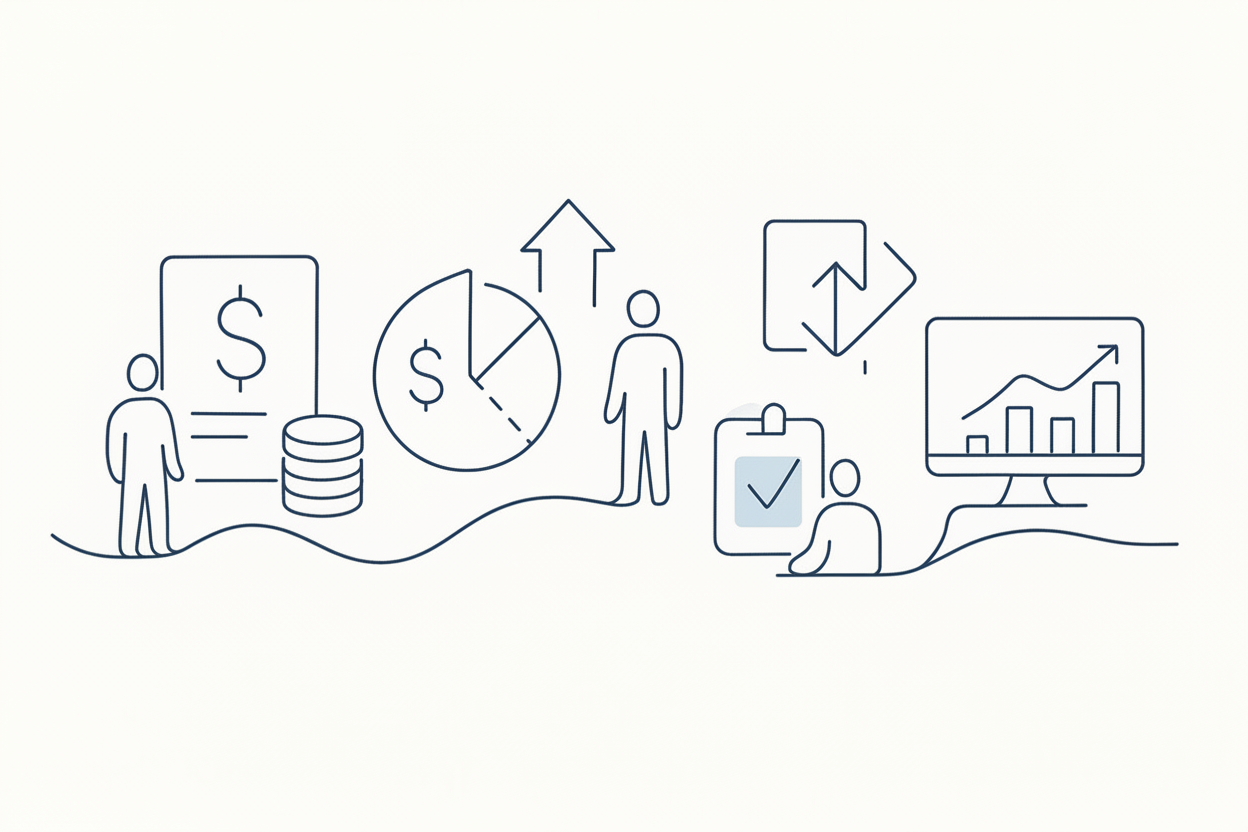AI's Impact on Market Efficiency

Understanding how AI unlocks hidden value in markets and enables traders to identify emerging trends before they become obvious.
Artificial intelligence and large language models are fundamentally transforming how traders identify opportunities, analyze markets, and extract value from information. Rather than signaling the end of capitalism or money, AI represents the next evolution in market efficiency—uncovering value that previously remained hidden due to information processing limitations.
The emergence of tools like ChatGPT, Claude, and specialized financial LLMs enables retail traders to analyze vast amounts of data at speeds and scales previously available only to institutional investors. This democratization of analytical capability creates both opportunities and challenges for market participants.
Unlocking Hidden Value
Consider a simple example: you own a bookshelf containing 100 books accumulated over years. You have no systematic understanding of their current market value—some might be common editions worth pennies, while others could be rare first editions worth thousands. Manually researching each book through eBay, specialized book marketplaces, and collector forums would take days or weeks.
An AI system could photograph your bookshelf, identify each title through image recognition, cross-reference current market prices across multiple platforms, assess condition based on visible details, and provide a comprehensive valuation report in minutes. This capability transforms dormant assets with unknown value into liquid, accurately-priced inventory.
Market Applications
This principle extends directly to financial markets. Assets, companies, and market segments constantly generate information through news releases, social media conversations, regulatory filings, and price action. Human analysts can only process a tiny fraction of this data stream, creating inefficiencies where information exists but hasn't been incorporated into prices.
AI systems excel at monitoring these diverse data sources, identifying patterns, and surfacing insights that human analysts would miss or discover too late to profit from. The trader who leverages AI to spot emerging trends gains informational edge over those relying on traditional analysis alone.
For automated trading through platforms like TradersPost, integrating AI-driven analysis into strategy logic enables systems to adapt to changing market conditions and identify opportunities based on information synthesis humans couldn't replicate.
Identifying Emerging Trends
Services like Exploding Topics monitor keyword search volumes and online discussions to identify phrases and concepts experiencing exponential growth in public interest. When a topic suddenly shifts from obscurity to widespread discussion, it often precedes commercial opportunities or shifts in consumer behavior.
Consumer Behavior Signals
Imagine if beanie babies suddenly showed exponential growth in online discussions, search volumes, and social media mentions. A trader with access to this trend data could research the parent company, anticipate increased sales and earnings, and establish positions before the broader market recognized the opportunity.
This represents informational edge—not insider trading or manipulation, but rather faster synthesis of publicly available signals into investment theses. AI enables this edge by continuously monitoring far more data sources than human analysts could track.
- Social Media Monitoring: LLMs can process millions of social media posts to detect sentiment shifts around brands, products, or sectors**
- News Analysis: AI systems categorize and extract key information from news articles, press releases, and filings faster than human readers
- Pattern Recognition: Machine learning identifies repeating patterns in price action, volume, and correlation structures that indicate regime changes
- **Alternative Data: Satellite imagery, credit card transactions, and web traffic data become analyzable at scale through AI processing
Enhanced Market Efficiency
AI improves market efficiency by accelerating information incorporation into prices. When significant news breaks, AI-driven trading systems can analyze implications, adjust positions, and execute trades in milliseconds—far faster than human decision-making cycles.
Price Discovery Improvements
This acceleration benefits market function by ensuring prices more accurately reflect available information. However, it also creates challenges for slower market participants who find themselves consistently trading against better-informed algorithms.
The competitive dynamic becomes who has better data sources, more sophisticated models, and faster execution infrastructure. Retail traders gain access to powerful tools through AI APIs and cloud computing, but institutional players maintain advantages in data access and computational resources.
Risk Management Applications
Beyond opportunity identification, AI enhances risk management by analyzing market dynamics in real-time and identifying developing risks before they materialize into losses. Systems can monitor correlations across thousands of securities, detect unusual patterns suggesting market stress, and adjust exposure accordingly.
For portfolios managed through TradersPost automation, AI-driven risk analytics can trigger position sizing adjustments, stop-loss modifications, or temporary strategy pauses based on changing market conditions.
Data Ownership and Value Exchange
An interesting question emerges around data ownership as AI systems increasingly rely on user-generated content for training and operation. Reddit, Twitter, and other platforms host billions of user conversations that provide valuable training data for LLMs.
The User as Product
These platforms traditionally monetize user data through advertising, effectively making users the product sold to advertisers. As AI training on this data creates substantial commercial value, questions arise about whether users should receive compensation for their contributions.
Blockchain-based solutions could enable micropayments every time AI systems access user-generated data, creating direct value exchange between data creators and data consumers. This would fundamentally restructure internet economics from advertising-based models to usage-based models.
For traders, this matters because the quality and availability of data directly affects AI system capabilities. If high-value data sources move behind paywalls or permission systems, the cost of maintaining informational edge increases.
Practical Implementation
Retail traders can begin leveraging AI for market analysis today through several accessible approaches:
LLM Integration for Research
Use ChatGPT, Claude, or specialized financial LLMs to:
- Summarize lengthy earnings call transcripts and extract key themes
- Analyze regulatory filings for material changes in business operations
- Generate investment thesis documents by synthesizing multiple information sources
- Translate complex financial concepts into understandable explanations
Sentiment Analysis Tools
Several platforms offer API access to social media sentiment analysis across stocks, cryptocurrencies, and other assets. Integrate these sentiment scores into trading systems as additional confirmation filters or alert triggers.
Pattern Recognition Systems
TradingView and similar platforms increasingly incorporate AI-assisted pattern recognition that identifies technical formations across thousands of charts simultaneously. This extends the reach of technical analysis beyond the handful of instruments any single trader could monitor manually.
News Aggregation and Filtering
AI-powered news aggregators can filter thousands of articles daily to surface only those relevant to your watchlist, with sentiment scoring and key quote extraction saving hours of manual reading.
Limitations and Considerations
While AI offers substantial advantages, important limitations constrain its effectiveness:
Historical Bias
AI models train on historical data and may struggle with genuinely novel situations that don't resemble past patterns. The COVID-19 pandemic, for example, created market conditions that no historical training data could adequately prepare models to handle.
Overfitting Risks
Sophisticated machine learning models can identify patterns in historical data that don't generalize to future periods—a phenomenon called overfitting. A model might achieve 90% accuracy on past data but fail completely on live markets because it learned noise rather than signal.
Computational Costs
Running advanced AI models requires substantial computational resources. While cloud computing makes this accessible, costs can accumulate quickly for retail traders processing large datasets or running complex models frequently.
Data Quality Dependencies
AI analysis quality depends entirely on input data quality. Garbage in, garbage out remains true regardless of model sophistication. Ensuring clean, accurate data feeds requires diligence and often investment in premium data sources.
The Evolution of Market Structure
As AI adoption spreads across market participants, the competitive landscape evolves. Early adopters gain temporary edges that eventually disappear as similar capabilities become universal. This progression resembles how basic technical analysis shifted from proprietary institutional tools to ubiquitous retail features.
Arms Race Dynamics
The AI edge becomes an arms race where maintaining advantage requires continuous improvement in models, data sources, and implementation speed. What works today becomes baseline tomorrow as competitors adopt similar approaches.
For retail traders, this suggests focusing on AI applications that complement human judgment rather than attempting to outcompete institutional algorithms purely on processing speed or model sophistication.
Hybrid Human-AI Approaches
The most effective near-term approach likely involves combining AI's pattern recognition and data processing capabilities with human judgment about market context, risk tolerance, and strategy selection. AI handles the heavy lifting of information synthesis while humans make final trading decisions.
Platforms like TradersPost enable this hybrid model by allowing traders to incorporate AI-generated signals into rule-based systems while maintaining human oversight of overall strategy logic and risk parameters.
Conclusion
AI and LLMs represent evolutionary rather than revolutionary changes in market structure. They accelerate information processing, improve pattern recognition, and enable analysis at scales humans cannot match. However, they don't eliminate the need for sound strategy logic, disciplined risk management, or realistic expectations about trading profitability.
The notion that AI signals the end of capitalism or money misunderstands both technology and economics. Instead, AI unlocks previously inaccessible value by making information processing more efficient. The total value in the economy expands as hidden assets become discoverable and tradeable.
For traders, the practical implication is clear: embrace AI as a tool for enhancing analytical capabilities while maintaining focus on fundamental principles of strategy design and risk management. Those who successfully integrate AI into their workflows gain informational edge, while those who ignore it risk falling behind as capabilities democratize across market participants.
Whether through automated systems managed via TradersPost or discretionary approaches enhanced by AI research tools, the opportunity exists for retail traders to compete more effectively with institutional players than ever before. The key lies in understanding AI's strengths and limitations while applying it to genuine market inefficiencies rather than assuming technology alone guarantees profits.




